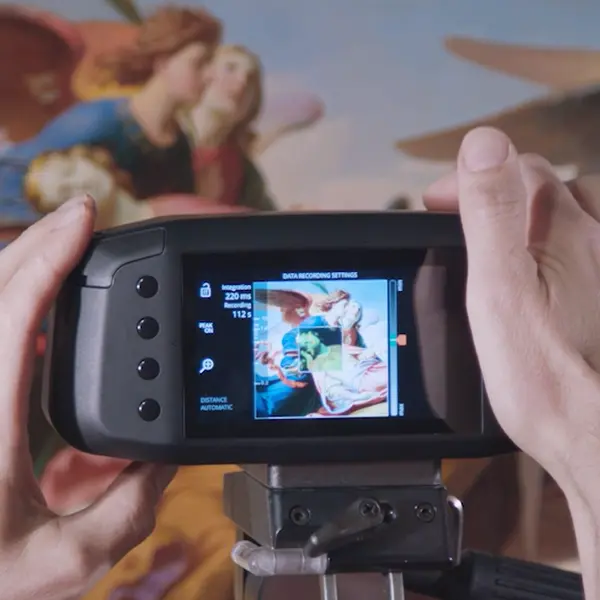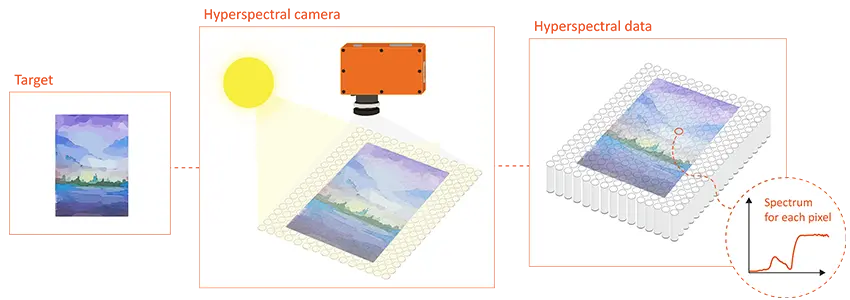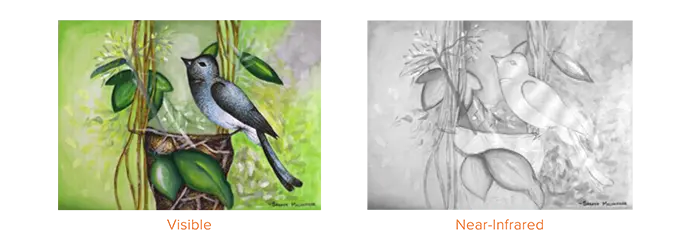Hyperspectral Imaging for Artworks Analysis and Investigation

Art conservation is a multidisciplinary field dedicated to preserving, protecting, and restoration of artworks and cultural artifacts. The primary goal of art conservation is to maintain the physical integrity and aesthetic qualities of these objects. Conservators and professionals in this field rely on various analytical techniques to identify materials used, diagnose deterioration, authenticate artworks, and implement effective preservation strategies. At present, imaging techniques like hyperspectral imaging are gaining prominence in various art conservation applications.
What is Hyperspectral Imaging?
Hyperspectral imaging is an advanced imaging technique that combines both spectroscopy and digital imaging techniques into single system called hyperspectral camera. It captures a series of images, each corresponding to a specific wavelength band. These bands are narrow, closely spaced, and can cover a wide range of the electromagnetic spectrum, including visible, near-infrared, and beyond.

Illustrative example of how hyperspectral imaging work.
The collected data is organized into a three-dimensional data cube, where two dimensions represent the spatial information (e.g., pixels in image), and the third dimension represents the spectral information (e.g., different wavelength bands). Each pixel in the data cube has associated spectral information, representing the intensity of light at different wavelengths. With the integration of both spatial and spectral information, it creates a rich and multidimensional dataset that is valuable for a wide range of analytical and identification purposes across diverse fields and industries. Hyperspectral imaging has found extensive application in various fields, such as agriculture, food, and plastics, and is now increasingly used in art conservation.
Hyperspectral Imaging for Artworks Analysis and Investigation
One of the significant advantages of hyperspectral imaging in art conservation is its non-invasive nature. Unlike traditional analytical techniques that require taking micro-samples from the artwork for laboratory analysis, hyperspectral imaging allows for analysis without any damage to the object, and this is particularly useful for old or delicate artworks.
Hyperspectral imaging also allows for the visualization of underlying layers or hidden features that are invisible to the naked eye. This capability has been particularly beneficial in identifying previous restorations, revealing underlying sketches or changes made by the artist during the creation process, and detecting forgeries. Using the spectral information, hyperspectral imaging can also characterize the distribution of different materials present in an object. This technique has proven to be especially useful in identifying pigments, binders, and other materials used in paintings, manuscripts, and other forms of art.
Different materials have distinct spectral signatures or responses to light. By using the relevant spectral range, hyperspectral imaging can target the spectral features associated with the materials of interest. In the context of artwork analysis and investigation, the commonly used spectral range are the VNIR (Visible and Near-Infrared), NIR (Near-Infrared), and SWIR (Short-Wave Infrared).
For instance, the visible spectrum is useful for identifying materials such as pigments and certain organic dyes. It can also be used to recreate colorimetric data in various color spaces like CIE L*a*b*, sRGB, and more. On the other hand, the NIR and SWIR spectrum enhance material identification, including binders and other organically based substances. Additionally, they enable visualization of hidden layers like under-drawings and retouches that are not visible in the visible spectrum.

Comparison of artwork between visible and near-infrared spectrum range.
Artwork courtesy of Shreya Sunil Malvankar.
There are various types of hyperspectral cameras available, including line scan (push broom), point scan (whisk broom), tunable filter, etc., and each type captures information in a distinct manner. When it comes to analyzing and investigating artwork, the line scan (push broom) hyperspectral camera offers several advantages. Line scan (push broom) hyperspectral cameras capture hyperspectral data along a line or strip while moving across a scene. These cameras record the spatial position from each line while capturing the spectral information at each spatial position, ensuring the resulting spectrum is perfectly co-registered. Unlike other types of hyperspectral cameras, Line scan (push broom) hyperspectral cameras don’t need instantaneous illumination of the entire scene. This simplifies the illumination setup, minimizes the overall illumination exposure, and reduces heat load, making them advantageous for delicate artwork analysis and inspection applications.
Specim Hyperspectral Imaging Systems and Solutions for Art Conservation
Specim, a member of the Konica Minolta group, offers a wide range of hyperspectral imaging solutions that are versatile and suitable for various industrial and research applications. Among the hyperspectral cameras offered by Specim, the Specim IQ, Specim FX, and Specim SWIR hyperspectral cameras have been widely utilized in the field of art conservation. For instance, the hyperspectral camera Specim IQ was utilized to identify and map pigment distribution on a Hebrew scroll. It was also used to analyze pigment distribution in neolithic rock paintings. Both the Specim FX and Specim SWIR hyperspectral cameras were employed to characterize pigments and binders, including the visualization of hidden inner layer underdrawings, in beehive panel painting. Moreover, the latter was also employed to identify and map the pigments and binders in two 15th-century Gothic altarpieces.

Hyperspectral imaging of artwork with SPECIM IQ.
Notably, the Specim IQ stands out as a portable and stand-alone hyperspectral camera that can be used both indoors and outdoors. This versatility expands the applications of hyperspectral imaging to new types of artworks, whether they are large-size wall paintings or inscriptions and paintings in hard-to-reach caves. Check out the video below to learn more about the capabilities of the Specim IQ hyperspectral camera.
WATCH VIDEO
To learn more about Specim’s hyperspectral imaging cameras and solutions, or if you need assistance in finding the right hyperspectral solutions for your artwork applications, don’t hesitate to contact us for a complimentary consultation.

